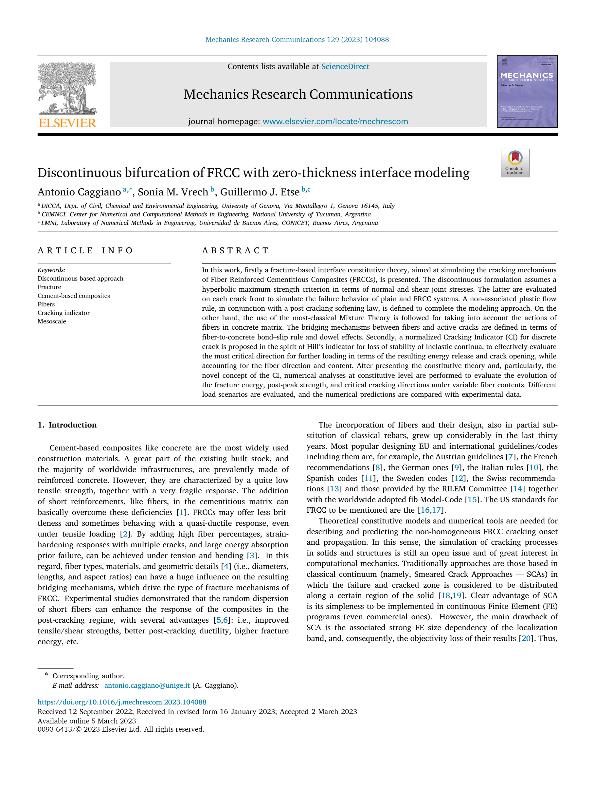Mostrar el registro sencillo del ítem
dc.contributor.author
Caggiano, Antonio
dc.contributor.author
Vrech, Sonia Mariel

dc.contributor.author
Etse, Jose Guillermo

dc.date.available
2023-10-17T17:46:02Z
dc.date.issued
2023-05
dc.identifier.citation
Caggiano, Antonio; Vrech, Sonia Mariel; Etse, Jose Guillermo; Discontinuous bifurcation of FRCC with zero-thickness interface modeling; Pergamon-Elsevier Science Ltd; Mechanics Research Communications; 129; 5-2023; 1-9
dc.identifier.issn
0093-6413
dc.identifier.uri
http://hdl.handle.net/11336/215220
dc.description.abstract
In this work, firstly a fracture-based interface constitutive theory, aimed at simulating the cracking mechanisms of Fiber Reinforced Cementitious Composites (FRCCs), is presented. The discontinuous formulation assumes a hyperbolic maximum strength criterion in terms of normal and shear joint stresses. The latter are evaluated on each crack front to simulate the failure behavior of plain and FRCC systems. A non-associated plastic flow rule, in conjunction with a post-cracking softening law, is defined to complete the modeling approach. On the other hand, the use of the most-classical Mixture Theory is followed for taking into account the actions of fibers in concrete matrix. The bridging mechanisms between fibers and active cracks are defined in terms of fiber-to-concrete bond–slip rule and dowel effects. Secondly, a normalized Cracking Indicator (CI) for discrete crack is proposed in the spirit of Hill's indicator for loss of stability of inelastic continua, to effectively evaluate the most critical direction for further loading in terms of the resulting energy release and crack opening, while accounting for the fiber direction and content. After presenting the constitutive theory and, particularly, the novel concept of the CI, numerical analyses at constitutive level are performed to evaluate the evolution of the fracture energy, post-peak strength, and critical cracking directions under variable fiber contents. Different load scenarios are evaluated, and the numerical predictions are compared with experimental data.
dc.format
application/pdf
dc.language.iso
eng
dc.publisher
Pergamon-Elsevier Science Ltd

dc.rights
info:eu-repo/semantics/openAccess
dc.rights.uri
https://creativecommons.org/licenses/by/2.5/ar/
dc.subject
CEMENT-BASED COMPOSITES
dc.subject
CRACKING INDICATOR
dc.subject
DISCONTINUOUS-BASED APPROACH
dc.subject
FIBERS
dc.subject
FRACTURE
dc.subject
MESOSCALE
dc.subject.classification
Otras Ingeniería Civil

dc.subject.classification
Ingeniería Civil

dc.subject.classification
INGENIERÍAS Y TECNOLOGÍAS

dc.title
Discontinuous bifurcation of FRCC with zero-thickness interface modeling
dc.type
info:eu-repo/semantics/article
dc.type
info:ar-repo/semantics/artículo
dc.type
info:eu-repo/semantics/publishedVersion
dc.date.updated
2023-10-12T14:56:42Z
dc.journal.volume
129
dc.journal.pagination
1-9
dc.journal.pais
Estados Unidos

dc.description.fil
Fil: Caggiano, Antonio. Università degli Studi di Genova; Italia
dc.description.fil
Fil: Vrech, Sonia Mariel. Universidad Nacional de Tucumán. Facultad de Ciencias Exactas y Tecnología; Argentina. Consejo Nacional de Investigaciones Científicas y Técnicas. Centro Científico Tecnológico Conicet - Tucumán; Argentina
dc.description.fil
Fil: Etse, Jose Guillermo. Universidad Nacional de Tucumán. Facultad de Ciencias Exactas y Tecnología; Argentina. Consejo Nacional de Investigaciones Científicas y Técnicas. Centro Científico Tecnológico Conicet - Tucumán; Argentina
dc.journal.title
Mechanics Research Communications

dc.relation.alternativeid
info:eu-repo/semantics/altIdentifier/url/https://linkinghub.elsevier.com/retrieve/pii/S0093641323000460
dc.relation.alternativeid
info:eu-repo/semantics/altIdentifier/doi/http://dx.doi.org/10.1016/j.mechrescom.2023.104088
Archivos asociados
